Dish Blight: The Ruins of Satellite TV Are All Around
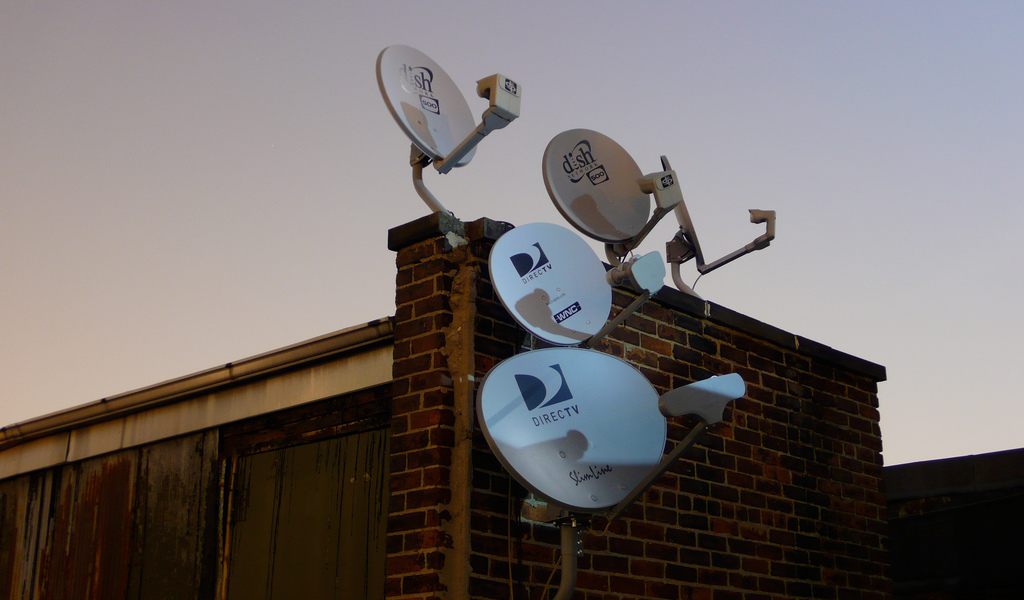
Satellite dishes in New York City. (Photo: Alexis Lê-Quôc/Flickr)
Right now, two major satellite television providers in the U.S., DirecTV and Dish, are both embroiled in merger talks with telecommunications giants. The former is nearly finished with an elaborate merger with AT&T, and earlier this month, the Wall Street Journal reported that Dish TV is in talks with T-Mobile. While both DirecTV and Dish are very successful companies, it will come as no surprise that the days of mounting a satellite dish on your house are waning.
But tell that to the thousands of satellite dishes hanging around on the rooftops of America’s houses. Installed and now abandoned, they spring from the sides of buildings like oyster mushrooms. It turns out that the responsibility for removing these eyesores doesn’t land on DirecTV and Dish—it’s up to individual renters and homeowners. Which might be news to satellite TV subscribers.
There’s a name for this growing eyesore: dish blight.
Satellite dishes, of course, are a global phenomenon. Dish blight, as it’s been called since around 2010, is a focus mostly in American cities, but it’s an issue that will hit every country that goes through the same pattern of cable/internet replacing satellite TV that we have now. For the time being, it’s American cities that have begun to take note of the phenomenon. DirecTV alone has over 20 million subscribers in the United States and nearly that many in Latin America, and given the rapid turnover of satellite TV, that leaves thousands abandoned in any given city.
“We understand there are upwards of 5,000 that are not in service, just sitting on the facades of properties,” Philadelphia councilman Darrell Clarke told Newsworks. Clarke, who represents a large stretch of Philadelphia’s many historic districts, pushed a bill through the city council in 2011 that’s designed to reduce the eyesore of satellite dishes in his district through efforts like repainting them to blend in with the building itself.
In turn, organizations ranging from the satellite companies to affordable housing advocates have protested the new bills, which they see as removing a low-cost connection option in favor of more expensive solutions like cable—in other words, some advocates see the fight against dish blight as a proxy war against the poor.
But how did we even get here? What is the deal with satellite dishes littering America’s urban homes?
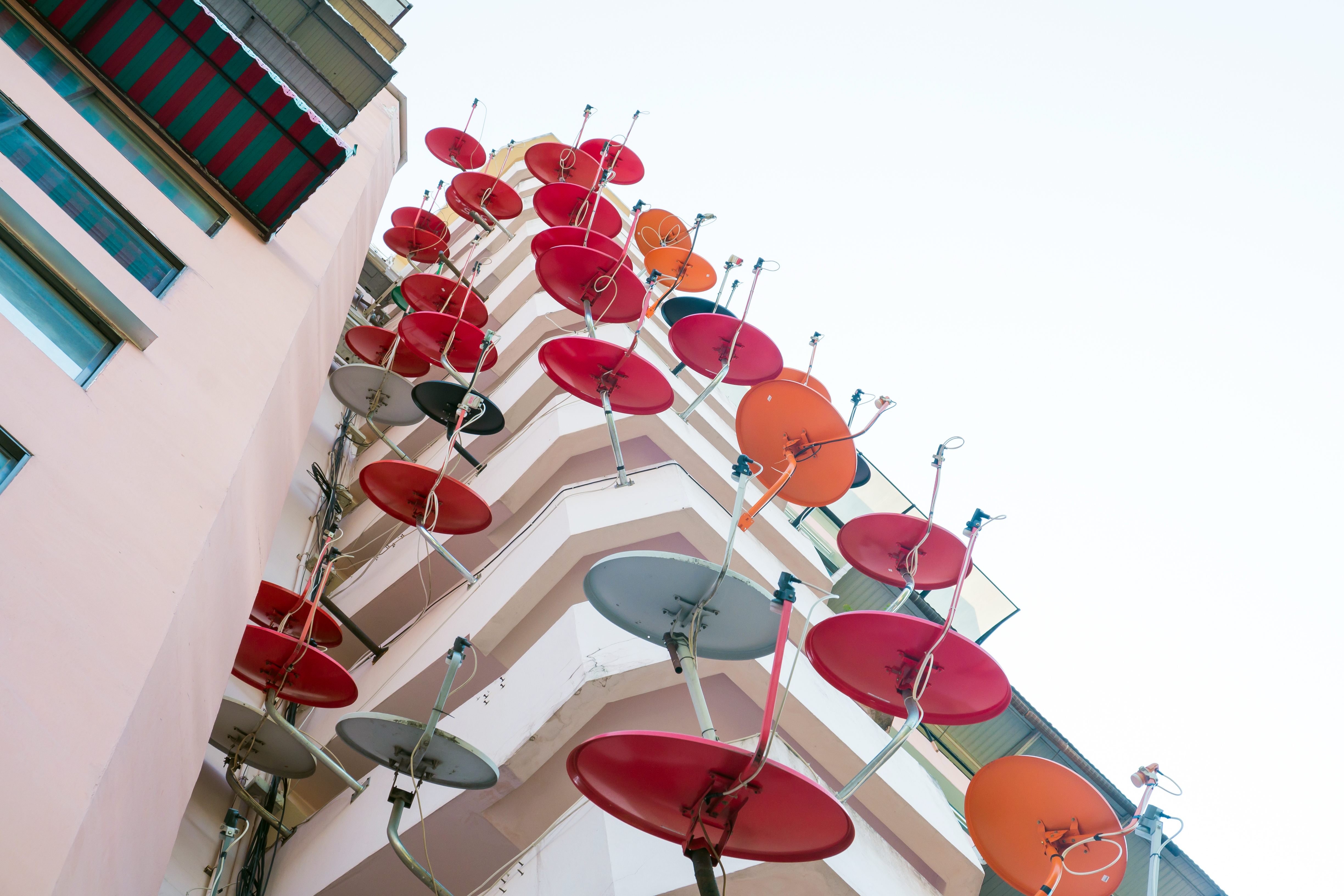 A more colorful installation. (Photo: David Ryo/shutterstock.com)
A more colorful installation. (Photo: David Ryo/shutterstock.com)
Satellite TV’s popularity represents a short-lived time of American telecommunications—both DirecTV and Dish launched within two years of each other (DirecTV in 1994 and Dish in 1996) and were immediately successful. The technology works like this: At a big facility somewhere down here on Earth, a giant satellite dish (like, 30 or 40 feet across) beams the signal (basically, all of the television streams) up to a satellite that’s orbiting the planet. That’s called the uplink. The satellite then beams the signal back down to Earth, where a smaller satellite dish, typically mounted on the outside of your home and pointed toward the heavens to receive its heavenly signal, captures said signal, called the downlink. Your personal dish is wired into (usually) a receiver, just like a cable box, which is attached to your TV.
In the 1980s, the airwaves were free, just like radio. You paid to construct your downlink satellite dish, which could cost a few thousand dollars, but after that, television didn’t cost anything. Anyone with one of these expensive satellite setups could watch pretty much anything. It still works that way elsewhere in the world; Iran, for example, routinely tries to crack down on satellites because they allow citizens to pick up non-state television.
DirecTV and Dish, though, started a new era of satellite TV wherein you had to pay to use the service, rather than the hardware. In fact, the companies would flat-out give the hardware away, which is what leads us to the problem of big ugly galvanized steel dishes jutting out of historic brownstones.
Satellite TV, like compact discs, was a blip, the last gasp of an old technology before the internet came in and disrupted everything. It also was a comparatively low-cost investment for the provider; they have to launch a satellite, sure, but compared to setting up high-speed cables throughout the entire world, or building wireless towers every quarter-mile, a single satellite costs pennies.
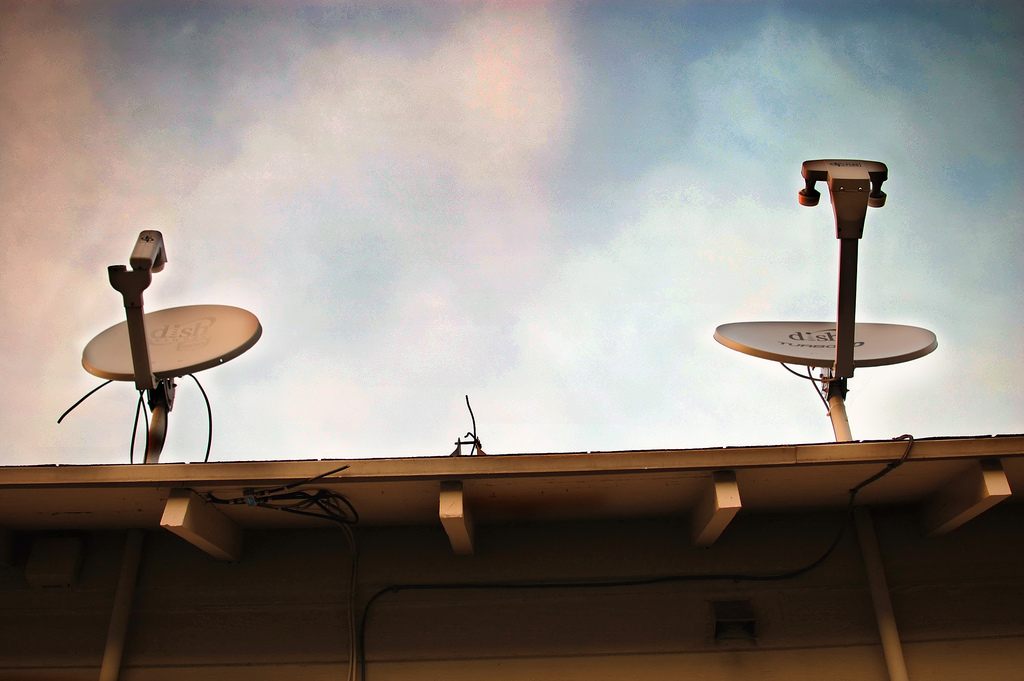 Dishes in California. (Photo: Rafael Castillo/flickr)
Dishes in California. (Photo: Rafael Castillo/flickr)
But as cable and internet infrastructure became more and more competitive, the (literally) down-to-earth nature of connecting your TV via a cable started to pay dividends. Cable TV is more reliable, can offer upgrades in quality with more ease, and, perhaps most importantly, is often bundled with internet service. (Satellite services can technically offer internet, but it’s notoriously slow and unreliable.)
Satellite’s brief but extremely popular period of glory left a physical mark on the places it touched. In Philadelphia, Boston, Brooklyn, and Chicago, among other cities, satellite dishes were installed by hundreds of thousands of renters. And here’s the weird thing: those dishes actually belong to that tenant, no matter where they are now or what sort of system (if any!) they use to get their TV. “Once installed, the dish, mount and associated cabling are contractually the property of the customer. Other than the receiver(s) DIRECTV does not collect the remainder of the system once the account is disconnected,” said a DirecTV representative in an emailed statement. Both DirecTV and Dish try to do the installation for free, or as cheap as possible—a major reason to choose satellite TV is its low cost, and the companies don’t want to scare away customers with hefty installation fees. So they’re free to install, but what about when the customer switches to cable, or cuts the cord, or simply moves away from the building? The dish stays.
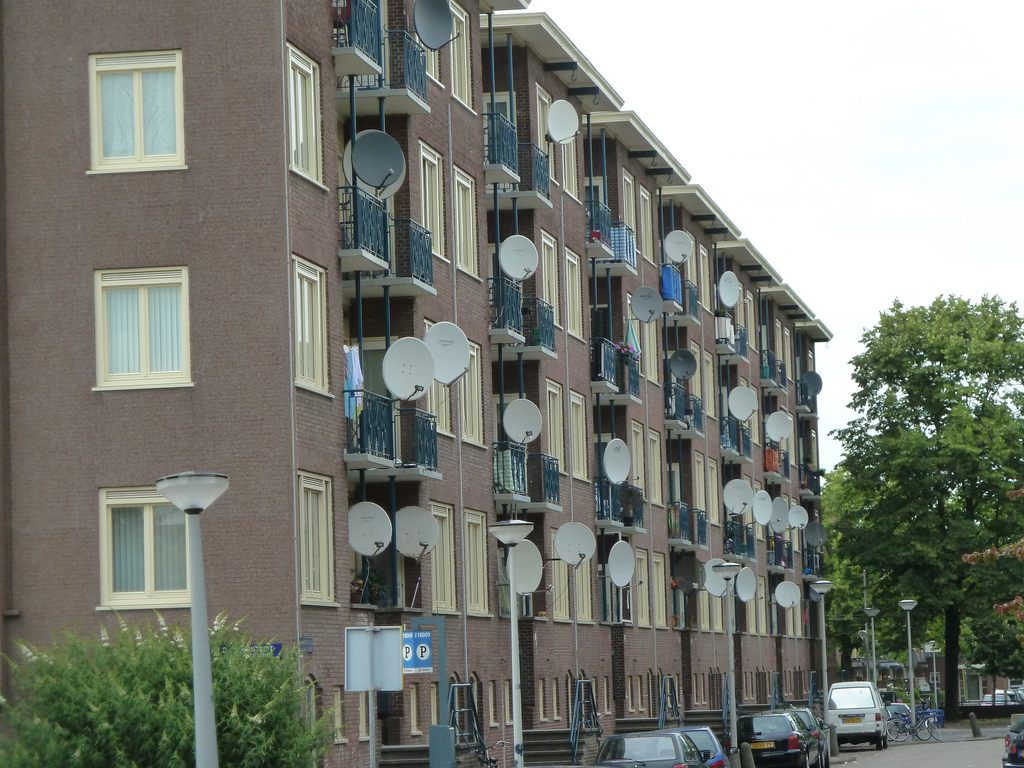 A satellite dish for nearly every balcony of this apartment block in Jordaan, Holland. (Photo: Karl Baron/flickr)
A satellite dish for nearly every balcony of this apartment block in Jordaan, Holland. (Photo: Karl Baron/flickr)
While a personal satellite dish is pretty small, typically somewhere between 19 and 24 inches in diameter, a standard dish weighs around 25-40 pounds. In apartment buildings with a lot of units, the installer has to navigate cabling as well, figuring out a way to run cables from the dish into the apartment of the customer. That leads to a lot of dishes being mounted right on the exterior of building.
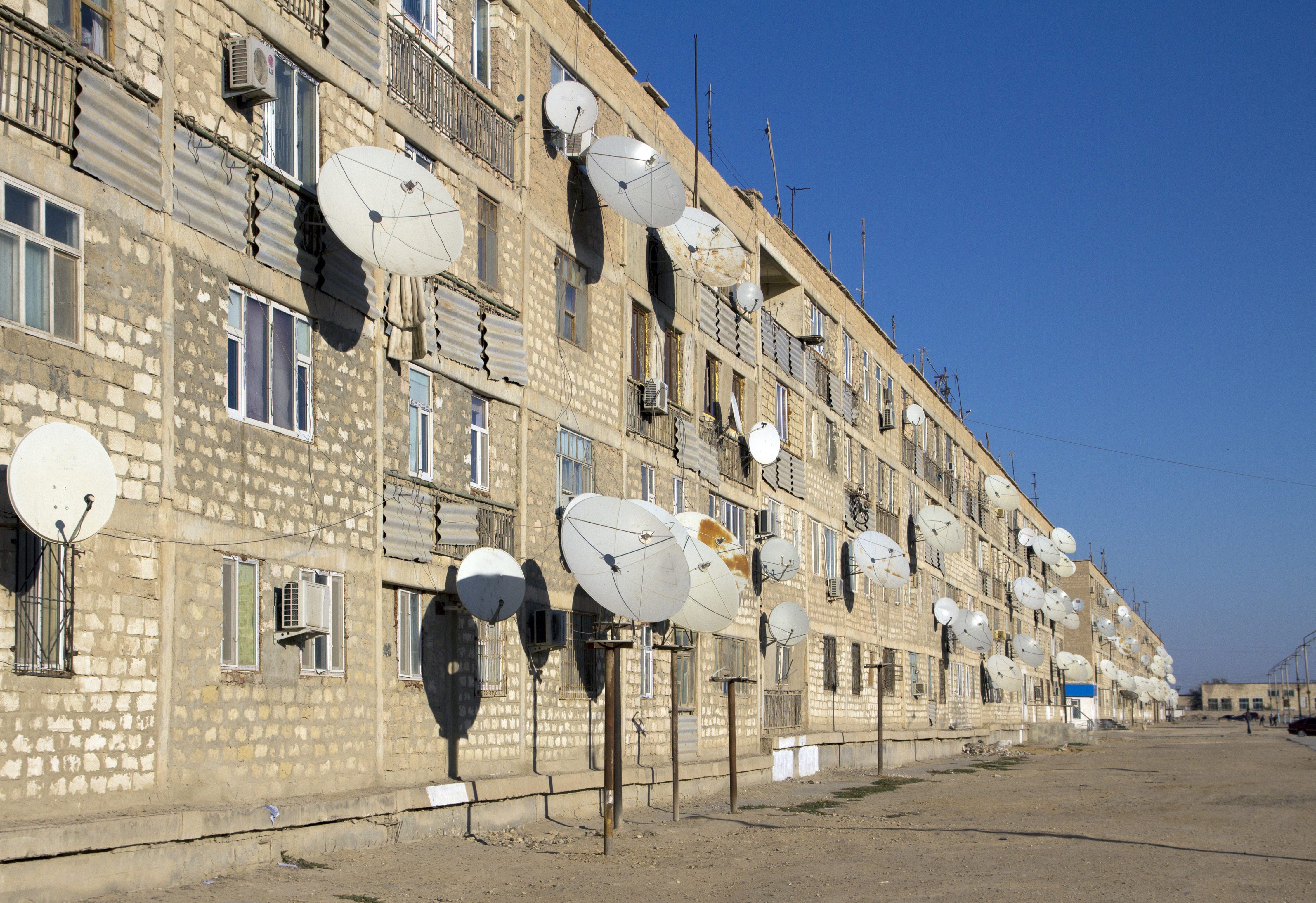 Old and new: dishes in Kazakhstan. (Photo: kzww/flickr)
Old and new: dishes in Kazakhstan. (Photo: kzww/flickr)
“I can see how it would really take away from the character of a neighborhood,” says Alison Frazee, director of advocacy for the Boston Preservation Alliance. She hasn’t seen much in terms of complaints about dish blight, but there’s been chatter about unused satellite dishes in Boston. Like in Philadelphia, Boston passed a city ordinance (theirs in 2012) seeking to limit the proliferation of satellite dishes that are in public view. In both cities, the satellite TV companies have challenged the ruling, saying it violates an earlier FCC law that places some very minimal limits on where a satellite may be mounted. But really, the goal is to keep it cheap and easy to install satellites, and who cares about the consequences?
Galvanized steel, a zinc-coated steel meant to resist rust, is a fairly easy material to recycle. But when a tenant moves, what are the chances he or she will head up to the roof or hang out of windows to uninstall a 25-pound dish, only to take it to an approved steel-recycling facility?
 In Berlin. (Photo: Bjørn Giesenbauer/flickr)
In Berlin. (Photo: Bjørn Giesenbauer/flickr)
And there’s no really easy way to reuse dishes, except for their original use of receiving satellite signals. (DirecTV says that when installing a new service, they first try out any old dishes on that property before installing a new one.) These aren’t like wooden pallets, the shipping crates that are easy to disassemble and have been a boon for DIYers and urban “makers.” You can’t really take a steel dish apart in a way that makes it useful for anything else; even using it to capture another signal, like WiFi, requires some pretty elaborate hacking. At best, maybe you can tilt it upwards and turn it into a pretty ugly bird bath.
Dish blight isn’t a big deal, not in terms of actually hurting or helping people; galvanized steel, though heavy and annoying, isn’t very toxic, and certainly an abandoned satellite dish won’t stop anyone from finding their next meal or medical service. But for some advocates, getting rid of dish blight is a first step towards changing the entire tenor of a neighborhood, in the same way that aggressive cleaning of subway car graffiti in New York City eventually led, indirectly and confusedly, to a safer subway system. Dish blight isn’t the worst problem faced by Councilman Clarke in Philadelphia. But those little eyesores won’t be walking themselves off the ledge.





Follow us on Twitter to get the latest on the world's hidden wonders.
Like us on Facebook to get the latest on the world's hidden wonders.
Follow us on Twitter Like us on Facebook